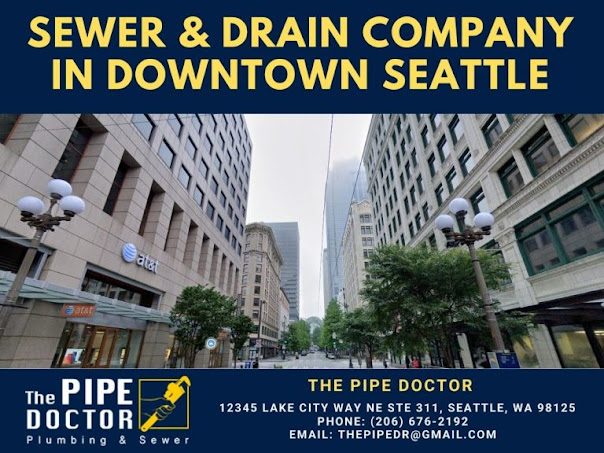Where Does Sewer Waste Go?
Being a homeowner entails keeping an eye on the condition of the sewer line that connects your house to the street. While it's true that the pipe linking your toilets to your public sewer line is easy to overlook, any obstructions or breaks in this pipe could result in costly sewer excavation and sewer repair. Let's learn more about your street sewer so that you can save time and money. Keep an eye on how it operates and where it goes so you don't have to deal with sewer issues in the future.
What Is a Street Sewer?

A street sewer's job is to transport wastewater from your sink, toilet and drains to the public sewer. When you own a home, you also own a street sewer that connects to the main public sewer line and is located beneath a street near your home. A lateral is a sewer pipe that runs beneath the street from your house to the main municipal sewer line. It's typically buried below the frost line in a properly prepared and slanted trench. The slope is significant in this process because it determines how well the pipe drains by gravity.
Installing a lateral involves 5 basic steps that are based on the local code authority and must gain approval after one or more inspections:
- The first step in the installation process is to determine how far the pipe needs to go and the depth of each end of the pipe. If you own a home, the sewer pipe usually starts where the home drain exits the house foundation. Sloping of the sewer line downhill will connect it to the city branch or main which is called a tap.
- The initial slope calculation results from the elevations and the length of the pipe. The reason why the slope calculation is very crucial during installation lies in its efficiency to drain properly. If the slope is too steep, it will cause the liquids to run faster than the solids, leading to clogs. However, if it is too shallow not enough velocity will be produced for proper drainage.
- When doing trenching for a sewer lateral, it should be done carefully to prevent unnecessary disturbance of the soil. To prevent soil disturbance, a narrow trench is recommended, but you need to have precise knowledge of where the pipe will terminate. Hence a wider trench is necessary. Make sure that the bottom of the trench is smooth and it’s best to put a bedding material such as sand to continuously support the pipe.
- Installing a sewer pipe should be done one section at a time, starting at the lower end and working up to the higher elevation. A pipe size of 4 inches is the suggested standard pipeline for residential lines. This depends on the local code of each city because they specify the required pipe material and size.
- Backfilling the trench can only be done if the sewer lateral is completely installed and passes the final inspection.
How does street sewer work and where does it go?
Communities with more people living have a sewer system that collects wastewater and takes it to the wastewater treatment facility.
As pipes from each house flow to a sewer main, they eventually run down the middle of the street. The sewer main flows into progressively larger pipes until it reaches the wastewater treatment plant. This is usually located in a low-lying area because it is completely gravity-powered. Some sewer systems have grinder-pump or lift stations to move the wastewater up over a hill. When the water reaches the wastewater treatment plant, it undergoes 3 stages of treatment:
- First stage: Primary treatment. The function is similar to a septic tank where it allows solid to settle out of the water and the scum to rise. The solid material will then be collected and disposed of either in a landfill or an incinerator.
- Second stage: Secondary treatment. This involves the removal of organic material and nutrients with the help of bacteria. There are settling tanks where wastewater flows and bacteria settle out. 90% of solids and organic materials from the wastewater may be removed through the second stage.
- Third stage: Tertiary treatment. This depends on the community and the composition of wastewater. The third stage typically uses chemicals to remove phosphorus and nitrogen from the water and will also include filter beds and other types of treatment under this stage. Chlorine is then added to the water to kill any remaining bacteria before it is discharged.
Once all three stages are complete, and the treated waste passes the regulatory standards of each state, it is then released to a nearby water body to be used for agricultural purposes or drinking consumption. Treated waste as a drinking water source will still undergo further water treatment to remove disease-causing agents. Most public drinking systems use different methods of water treatment to provide safe drinking water for their communities.
Looking for Expert Plumbers to Help You with your Sewer Issues? Call The Pipe Doctor!
The Pipe Doctor provides different sewer services such as sewer repair, sewer cleaning, sewer replacement, and sewer inspection. If you are looking for an affordable and reliable plumbing and sewer experts, don’t hesitate to give us a call or shoot us an email!
The Pipe Doctor
12345 Lake City Way Ste 311 Seattle, WA 98125
(206) 676-2192
thepipedr@gmail.com
Other Plumbing Services
- Hydro Jetting
- Sewer Video Inspection
- Sewer Line Repair and Cleaning
- Drain Repair and Cleaning
- General Plumbing
External Links:
Twitter: https://twitter.com/The_pipedrTumblr: https://thepipedr1.tumblr.com/
Instagram: https://www.instagram.com/thepipedr1/
WordPress: https://thepipedr1.wordpress.com
Trello: https://trello.com/thepipedoctor

Comments
Post a Comment